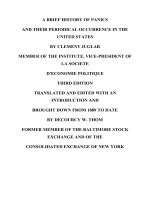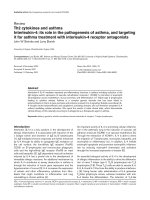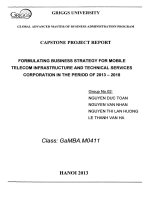CHARACTERISATION OF GLUTAMYL TRANSPEPTIDASE AND ELUCIDATING ITS ROLES IN THE PATHOGENESIS OF HELICOBACTER PYLORI
Bạn đang xem bản rút gọn của tài liệu. Xem và tải ngay bản đầy đủ của tài liệu tại đây (8.47 MB, 281 trang )
CHARACTERIZATION OF
γ-GLUTAMYL TRANSPEPTIDASE
AND ELUCIDATING ITS ROLES IN THE
PATHOGENESIS OF HELICOBACTER PYLORI
LING SHI MIN, SAMANTHA
(B.Sc. (Hons.), NUS)
A THESIS SUBMITTED
FOR THE DEGREE OF DOCTOR OF PHILOSOPHY
DEPARTMENT OF MICROBIOLOGY
NATIONAL UNIVERSITY OF SINGAPORE
2012
Acknowledgements
i
ACKNOWLEDGEMENTS
First and foremost, I would like to express my heartfelt gratitude to my
supervisor A/P Ho Bow for his patient guidance, encouragement and invaluable
support throughout this project. Over these years, he has taught me how to think like a
scientist and how to form the right questions to do good science. Without him, this
dissertation would definitely not have been possible.
I must also acknowledge Han Chong, my lab officer, for his technical support
and friendship throughout my time in this lab as a PhD student. Special thanks also go
to Gong Min, Shuxian and Meiling for all their help and invaluable suggestions
especially when I just started out on this project. Appreciation goes out to all my
fellow postgraduate students in the Helicobacter pylori Research Lab (both past and
present), including Yan Wing, Yunshan, Mun Fai, Ammar, Vinod and Jin Huei.
Thank you for all the help and assistance provided in one way or another. I would also
like to specially thank my fiancé and also my best lab mate, Alvin, for always being
there for me and for providing me with his continuous support.
I am also grateful to my wonderful family for their love, encouragement and
support throughout this time.
Finally, I recognize that this research would not have been possible if not for
the financial, academic and technical support of the National University of Singapore,
particularly in the award of the NUS Research Scholarship that provided the
necessary financial support for this research.
Table of Contents
ii
CONTENTS PAGE
ACKNOWLEDGEMENTS i
TABLE OF CONTENTS ii
SUMMARY xiii
LIST OF TABLES xv
LIST OF FIGURES xvi
LIST OF VIDEOS xix
LIST OF ABBREVIATIONS xx
LIST OF PUBLICATIONS xxiii
1. INTRODUCTION
1.1 Association of Helicobacter pylori and gastroduodenal diseases 1
1.2 Virulence factors of H. pylori 1
1.3 γ-glutamyl transpeptidase (GGT) 3
1.3.1 H. pylori GGT 3
1.3.2 GGT and H. pylori pathogenesis 4
1.4 Objectives of the study 5
2. LITERATURE SURVEY
2.1 Helicobacter pylori – the organism 6
2.1.1 History 6
2.1.2 Characteristics of H. pylori 7
2.1.2.1 Morphological forms 7
2.1.2.2 Growth requirements 8
Table of Contents
iii
2.2 Epidemiology of H. pylori infections 8
2.2.1 Prevalence of H. pylori 8
2.2.2 Routes of transmission 9
2.3 H. pylori-associated diseases 10
2.4 Virulent determinants of H. pylori pathogenesis 11
2.4.1 Cell surface factors 11
2.4.1.1 Flagella 11
2.4.1.2 Adhesins and outer membrane proteins 12
2.4.1.3 Lipopolysaccharides (LPS) 13
2.4.2 Cytotoxin-associated gene pathogenicity island (cagPAI) 14
2.4.3 Cytotoxin-associated gene A (CagA) 15
2.4.4 Vacuolating cytotoxin A (VacA) 16
2.4.5 Enzymes 18
2.4.5.1 Urease 18
2.4.5.2 Catalase 18
2.4.5.3 Phospholipase A 19
2.5 Effects of H. pylori infection on host 19
2.5.1 Oxidative stress 20
2.5.1.1 H. pylori and reactive oxygen species (ROS) generation 20
2.5.1.2 H. pylori decreases antioxidant levels 21
2.5.2 H. pylori and inflammation 22
2.5.2.1 Interleukin 8 (IL-8) generation 23
2.5.3 Cellular vacuolation 24
2.5.3.1 Role of VacA in vacuolation 25
2.5.3.2 Role of urease and ammonia in vacuolation 26
Table of Contents
iv
2.6 GGT 27
2.6.1 Human GGT 27
2.6.1.1 Properties and catalytic action 27
2.6.1.2 Physiological function 29
2.6.1.3 Cellular expression 30
2.6.2 H. pylori GGT 31
2.6.2.1 Properties of GGT 31
2.6.2.2 Comparison between H. pylori GGT and human GGT 31
2.6.2.3 Physiological role of GGT in H. pylori 32
2.6.2.4 Effects of H. pylori GGT on the host 32
2.7 Host internalization of H. pylori proteins 34
2.7.1 Endocytosis pathways 35
2.7.1.1 Phagocytosis 36
2.7.1.2 Pinocytosis 36
2.7.1.2.1 Macropinocytosis 36
2.7.1.2.2 Clathrin-dependent endocytosis 37
2.7.1.2.3 Caveolin-mediated endocytosis 37
2.7.1.2.4 Clathrin- and caveolin-independent endocytosis 38
2.7.2 Mechanisms of nuclear import 38
2.7.2.1 Classical pathway 38
2.7.2.2 Alternative pathways 39
3. MATERIALS AND METHODS
3.1 H. pylori strains used in the study 41
3.1.1 Growth conditions 41
Table of Contents
v
3.1.2 Maintenance of H. pylori cultures 42
3.2 Genotyping of H. pylori virulence genes 42
3.2.1 Genomic DNA extraction 42
3.2.2 Polymerase Chain Reaction (PCR) 43
3.2.3. Agarose gel electrophoresis 44
3.3 Bradford protein assay 44
3.4 Sodium dodecyl sulphate-polyacrylamide gel electrophoresis 45
(SDS-PAGE)
3.4.1 Preparation of SDS-polyacrylamide gel 45
3.4.2 Sample preparation and electrophoretic gel run 45
3.4.3 Gel staining and visualization of protein bands 45
3.5 Cloning and expression of recombinant full length GGT (rGGT), 46
large subunit (rGGTL) and small subunit of GGT (rGGTS)
3.5.1 Construction of pRSET-ggt, pRSET-ggtl and pRSET-ggts 46
3.5.1.1 Cloning strategy 46
3.5.1.2 PCR amplification of ggt, ggtl and ggts 48
3.5.1.3 Restriction enzyme digestion 48
3.5.1.4 Extraction and purification of insert and plasmid vector 49
3.5.1.5 Ligation of insert into expression vector pRSET-A 49
3.5.2 Transformation of Escherichia coli 49
3.5.2.1 E. coli strains 49
3.5.2.2 Preparation of competent E. coli 50
3.5.2.3 Transformation and selection of positive clones 50
3.5.3 Purification and identification of recombinant plasmid 51
3.5.3.1 DNA sequencing 51
3.5.4 Expression of rGGT, rGGTL and rGGTS 52
Table of Contents
vi
3.5.4.1 Induction of target proteins 52
3.5.4.2 Localization of target proteins 53
3.5.5 Purification of rGGT, rGGTL and rGGTS 53
3.5.5.1 Preparation of cell extracts 53
3.5.5.2 His-Tag affinity chromatography 54
3.5.5.3 Dialysis of purified recombinant proteins 55
3.5.5.4 Mass spectrometry 55
3.5.5.5 GGT activity assay 57
3.6 Raising antibody against rGGTS and rGGT 57
3.6.1 Raising polyclonal antibody in rabbits using rGGTS 57
3.6.1.1 Immunization procedure 58
3.6.1.2 Enzyme-linked immunosorbent assay (ELISA) 58
3.6.1.3 Purification of anti-rGGTS antibody 59
3.6.1.4 Characterization of antibody by western blot analysis 59
3.6.2 Raising monoclonal antibody (MAb) in mice using rGGT 60
3.6.2.1 Immunization, fusion and ascites production 60
3.6.2.2 Characterization of MAbs from different clones 61
3.6.2.3 Epitope mapping strategy 61
3.7 Neutralization of GGT activity using MAbs 62
3.8 Purification of native GGT (nGGT) from H. pylori 62
3.8.1 Culture of H. pylori 62
3.8.2 Preparation of immunoaffinity resin 63
3.8.3 Immunoaffinity chromatography 63
3.9 Immunogold-labeling transmission electron microscopy (TEM) 64
3.9.1 Preparation of cells and ultrathin sectioning 64
Table of Contents
vii
3.9.2 Localization of GGT in H. pylori 64
3.10 Construction of deletion mutants in H. pylori by a PCR-based approach 65
3.10.1 Design of gene-targeting constructs 65
3.10.2 Transformation of H. pylori with gene-targeting DNA constructs 68
3.10.3 Identification of isogenic H. pylori mutant of interest 69
3.11 Cell culture 69
3.11.1 AGS gastric cancer epithelial cells 69
3.11.2 HeLa cervical cancer cells 70
3.11.3 Primary human gastric cells 70
3.11.3.1 Tissue collection 70
3.11.3.2 Coating of culture dishes 71
3.11.3.3 Isolation and culture of gastric cells 71
3.11.4 Primary human macrophages 72
3.12 Host-pathogen interaction study 72
3.12.1 Enumeration of cells 72
3.12.2 Enumeration of bacteria 72
3.12.3 Infection study 73
3.13 Role of GGT in ROS generation 74
3.13.1 Hydrogen peroxide (H
2
O
2
) assay 74
3.13.2 NF-κB activation 74
3.13.2.1 Extraction of cytosolic and nuclear fractions 74
3.13.2.2 Western blot analysis 75
3.13.3 Determination of IL-8 production 76
3.14 Role of intracellular GGT in AGS cells 77
3.14.1 Presence of H. pylori GGT in host cells 77
Table of Contents
viii
3.14.1.1 TEM 77
3.14.1.2 Confocal laser scanning microscopy (CLSM) analysis 77
3.14.1.3 Western blot analysis 78
3.14.2 Endocytosis of GGT 78
3.14.2.1 Specificity of uptake 78
3.14.2.2 Inhibitor study 78
3.14.3 Co-immunoprecipitation (Co-IP) 79
3.14.4 Small interfering RNA (siRNA) knockdown of importin β1 80
3.14.5 Intracellular glutathione (GSH) analysis 81
3.15 Assessment of role of GGT in vacuolation 82
3.15.1 Cell morphology 82
3.15.2 Neutral red dye uptake assay 83
3.15.3 Inhibitor studies 83
3.15.3.1 Serine-borate complex (SBC) 83
3.15.3.2 MAbs against GGT 83
3.16 Detection of serum antibody against rGGT in H. pylori-infected patients 84
3.17 Statistical analysis 84
4. RESULTS
4.1 Genotyping of H. pylori 85
4.2 Cloning and expression of rGGT, rGGTL and rGGTS 85
4.2.1 Construction of pRSET-ggt, pRSET-ggtl and pRSET-ggts 85
4.2.2 Identification of positive clones after transformation 87
4.2.3 Expression of rGGT, rGGTL and rGGTS 89
4.2.4 Localization of rGGT, rGGTL and rGGTS in different cell 91
fractions
Table of Contents
ix
4.2.5 Purification of recombinant proteins by His-tag affinity 92
chromatography
4.2.6 Confirming identity of rGGT by mass spectrometry 94
4.3 Antibody production 95
4.3.1 Polyclonal antibody against rGGTS 95
4.3.1.1 Purification and characterization 95
4.3.2 Monoclonal antibody against rGGT 97
4.3.2.1 Screening of immunized mice 97
4.3.2.2 Characterization of MAbs 98
4.3.2.3 Mapping of epitopes 99
4.4 Inhibition of GGT catalytic activity by MAbs 102
4.4.1 Examination of neutralizing activity of MAbs from different clones 102
4.4.2 Neutralizing activity of MAbs on different H. pylori strains 102
4.4.3 Comparison of H. pylori 88-3887 GGT amino acid sequence with 105
other GGTs
4.5 Purification of nGGT from H. pylori 106
4.5.1 Total yield and recovery 106
4.6 Localization of GGT in H. pylori by immunogold-labeling TEM 107
4.7 Construction of various H. pylori isogenic mutants 111
4.8 Enumeration of H. pylori 116
4.9 H. pylori GGT and H
2
O
2
generation 116
4.9.1 GGT induces H
2
O
2
production 116
4.9.2 Effects of inhibitor and enhancer on GSH-dependent iron reduction 118
4.9.3 H. pylori GGT induces NF-κB activation 119
4.9.4 H. pylori GGT and IL-8 production 120
4.9.4.1 IL-8 production induced by GGT 120
Table of Contents
x
4.9.4.2 Role of CagA and cagPAI in IL-8 induction 122
4.10 Internalization of H. pylori GGT in host cells 123
4.10.1 TEM 123
4.10.2 CLSM 128
4.10.3 Western blot analysis of different cell fractions 129
4.10.4 Internalization of GGT by cells is a specific process 130
4.10.4.1 GGT is endocytosed by a clathrin-dependent pathway 131
4.10.5 Nuclear import of GGT is dependent on importin β1 135
4.10.5.1 GGT forms a complex with host protein importin β1 135
4.10.5.2 siRNA knockdown of importin β1 137
4.10.6 Role of GGT in affecting nuclear GSH levels in AGS cells 140
4.10.6.1 Inhibition of endocytosis of GGT 144
4.10.6.2 Inhibition of nuclear import of GGT 145
4.11 Role of H. pylori GGT in potentiating vacuolation in host cells 146
4.11.1 Real-time phase contrast microscopy of vacuolation formation 146
in H. pylori-infected AGS cells
4.11.2 Vacuolation induction in AGS cells treated with H. pylori 150
4.11.3 Cellular vacuolation in various cell types infected with H. pylori 151
4.11.4 Involvement of GGT, VacA and urease in cellular vacuolation 154
4.11.5 Role of ammonia produced by GGT 156
4.11.5.1 Vacuolation in glutamine-free media 156
4.11.5.2 Rescue of vacuolation induction using exogenous 157
ammonium chloride
4.11.6 Inhibition of GGT activity and its effects on vacuolation 158
4.12 Antibody titre against rGGT in patients infected with H. pylori 159
Table of Contents
xi
5. DISCUSSION
5.1 Cloning, expression and purification of rGGT, rGGTL and rGGTS 160
5.2 MAbs against rGGT 161
5.2.1 Epitopes recognized by MAbs – possible mode of inhibition 161
5.2.2 Inhibitory action of MAbs on GGT activity – comparison between 163
H. pylori strains and with other organisms
5.2.3 Isotypes of MAbs generated against rGGT 164
5.3 Purification of nGGT using MAb 164
5.4 Subcellular localization of GGT in H. pylori 165
5.5 Pathogenic effects of GGT on host cells 167
5.5.1 H. pylori GGT and H
2
O
2
production 167
5.5.1.1 H. pylori GGT induces NF-κB activation and IL-8 169
upregulation in various cell types
5.5.1.1.1 Contributory role of cagPAI but not CagA 172
5.5.1.2 H. pylori GGT and DNA damage 173
5.5.2 Internalization of H. pylori GGT by gastric epithelial cells 174
5.5.2.1 Endocytosis pathway involved 174
5.5.2.2 Nuclear import mechanism 177
5.5.2.3 GGT depletes nuclear GSH 178
5.5.3 H. pylori GGT potentiates cell vacuolation 181
5.5.3.1 Morphological changes induced by GGT 181
5.5.3.2 Observations among different cell lines used 182
5.5.3.3 Interplay between H. pylori GGT, urease and VacA in 183
vacuolation
5.5.4 Proposed mechanism of GGT-mediated H. pylori pathogenesis 185
5.6 GGT as a potential diagnostic marker for H. pylori infections 187
5.7 Conclusion 189
Table of Contents
xii
5.8 Future work 190
6. REFERENCES 192
7. APPENDICES I
SUMMARY
Summary
xiii
Helicobacter pylori is a major etiological agent of various gastroduodenal
diseases. Of the known virulence factors of H. pylori, γ-glutamyl transpeptidase
(GGT) is reported to induce apoptosis in host cells. However, its role in H. pylori
pathogenesis is still not well characterized.
H. pylori GGT is a heterodimer consisting of a large and small subunit.
Cloning, expression and purification of recombinant full length GGT (rGGT), large
subunit (rGGTL) and small subunit (rGGTS) were carried out. Monoclonal antibodies
raised against rGGT inhibited the enzymatic activity of H. pylori GGT by up to 93%.
The neutralizing epitope was identified as 428-GNPNLYG-434 and spans a Tyrosine-
433 containing loop previously reported to be important for catalysis.
Purified native GGT (nGGT) was found to generate H
2
O
2
through thiol-
dependent iron reduction as treatment with desferrioxamine (an Fe
3+
chelator)
significantly inhibited this effect. GGT was further found to activate NF-κB and
induce interleukin-8 (IL-8) generation in various cell types including primary human
gastric cells and macrophages, suggesting a pro-inflammatory effect.
Intriguingly, GGT was discovered to localize in host cell nuclei as observed
by transmission electron microscopy, confocal laser scanning microscopy and western
blot analysis. The internalization of GGT by AGS cells was identified to occur via the
clathrin-mediated endocytosis pathway. GGT was also demonstrated to co-
immunoprecipitate with importin β1, suggesting that nuclear import of GGT may be
mediated by importin β1. Indeed, siRNA knockdown of importin β1 significantly
inhibited the nuclear import of GGT, confirming our hypothesis. Interestingly, nuclear
localization of GGT coincided with a decrease in the levels of glutathione in the
nucleus, indicative of a role of GGT in causing redox imbalance in host cells.
Summary
xiv
H. pylori has been reported to cause cellular vacuolation in host cells, a
phenomenon attributed to vacuolating cytotoxin and the presence of weak bases. In
this study, the process of vacuolation was recorded over 24 hours using real-time
microscopy and it was observed that Δggt induced less vacuolation in AGS cells as
compared to the parental strain. Vacuolating ability of wild type was also significantly
reduced in the absence of glutamine while exogenous ammonium chloride rescued the
ability of Δggt to induce vacuolation as determined by neutral red assay. Hence, this
indicates that ammonia generated by GGT through glutamine hydrolysis is an
important contributory factor to vacuolation.
rGGT was also shown to exhibit potential as a diagnostic marker for H. pylori
infection as significantly higher anti-GGT antibody levels (P<0.01) were detected in
H. pylori-positive subjects (n=58) compared to H. pylori-negative controls (n=65).
This suggests that GGT is capable of provoking an immune response in the host.
In conclusion, this study has demonstrated the capability of GGT in generating
H
2
O
2
, activating NF-κB and upregulating IL-8 in host cells. Furthermore, GGT is
endocytosed by gastric cells and subsequently transported into the cell nucleus where
it depletes nuclear glutathione. In addition, GGT also strongly potentiates vacuolation
by generating ammonia from glutamine hydrolysis. Taken together, GGT has been
shown to be a potent virulence factor that ignites multiple pathways leading to host
cell damage.
List of Tables
xv
LIST OF TABLES PAGE
1.
Antibiotic resistance of constructed H. pylori mutants
42
2.
Primers used to amplify various virulence genes of H. pylori
44
3.
Sequences of primers used to amplify ggt, ggtl and ggts
48
4.
Primers for DNA sequencing of ggt, ggtl and ggts gene inserts
cloned into pRSET-A vector
52
5.
Primers used for the construction of isogenic mutants
67
6.
Primers used to check for positive isogenic mutants
69
7.
Summary of MAb isotypes and specificities
99
8.
Inhibition of vacuolating activity of H. pylori by MAbs
159
List of Figures
xvi
LIST OF FIGURES PAGE
1.
Schematic illustration of a model depicting how VacA induces
cellular vacuolation
26
2.
The γ-glutamyl cycle
30
3.
Different pathways of endocytosis
36
4.
The classical nuclear import cycle
39
5.
Schematic construction of pRSET-ggt, pRSET-ggtl and pRSET-ggts
recombinant expression vector
47
6.
Diagrammatical representation of gene-targeting construct
68
7.
Genotyping of virulence genes in H. pylori strain 88-3887
85
8.
DNA gel electrophoresis of gene fragments encoding ggt, ggtl and
ggts
86
9.
Restriction enzyme digest of expression vector pRSET-A
87
10.
Screening of positive clones by restriction enzyme digest
88
11.
DNA sequences of H. pylori 88-3887 ggt, ggtl and ggts gene
fragments cloned into pRSET-A
89
12.
Expressed recombinant proteins after IPTG induction
90
13.
SDS-PAGE protein profile of soluble and insoluble protein fractions
92
14.
His-Tag affinity purification of recombinant proteins
93
15.
Identification by MALDI-TOF mass spectrometry of the 3 protein
bands of purified rGGT
95
16.
Antibody production profile
96
17.
Western blot analysis using antiserum against rGGTS
96
18.
ELISA and western blot analysis using antiserum against rGGT
97
19.
Specificity of MAbs raised against rGGT
99
20.
Identification of epitopes recognized by MAbs
100
21.
3-D structures of individual large and small subunits of rGGT
illustrating the epitopes which MAbs bind to
101
List of Figures
xvii
22.
Neutralizing ability of MAbs on H. pylori 88-3887 GGT activity
102
23.
Neutralizing ability of MAbs on different H. pylori strains
103
24.
Neutralizing ability of MAb 1G1 on various clinical H. pylori strains
104
25.
Comparison of amino acid sequence of H. pylori GGT (residues
416-464) and that of other bacterial and mammalian homologues
105
26.
SDS-PAGE of purified native H. pylori GGT (nGGT)
106
27.
Localization of GGT in H. pylori by immunogold-labeling TEM
108
28.
PCR amplified products for generation of various knockout
constructs
111
29.
Identification of isogenic mutants by PCR amplification
113
30.
Standard curve for enumeration of H. pylori
116
31.
Effect of H. pylori GGT on H
2
O
2
generation
117
32.
H. pylori purified native GGT induces H
2
O
2
generation in AGS cells
118
33.
H. pylori GGT induces NF-κB activation
119
34.
H. pylori GGT induces IL-8 production from various cell types
121
35.
Involvement of H. pylori cagPAI in IL-8 induction in AGS cells
122
36.
Localization of H. pylori GGT in AGS cells 24 hours post-infection
124
37.
CLSM micrographs showing presence of H. pylori GGT in AGS cell
nuclei
128
38.
H. pylori GGT enters into host cells
129
39.
rGGT enters into host cells
130
40.
Heat-denatured rGGT is unable to enter into AGS cells
130
41.
rGGTL and rGGTS are unable to enter into AGS cells separately
131
42.
Assessment of drug cytotoxicity of CPZ and NYS to AGS cells
132
43.
Effect of CPZ and NYS on rGGT internalization by AGS cells 133
44.
CLSM micrographs showing inhibition of rGGT internalization in
the presence of CPZ
134
List of Figures
xviii
45.
H. pylori GGT co-immunoprecipitates with importin β1
136
46.
Dose-dependent knockdown of importin β1 using siRNA
137
47.
Nuclear import of GGT is dependent on importin β1
139
48.
H. pylori GGT depletes nuclear GSH
141
49.
Intracellular rGGT depletes nuclear GSH
144
50.
Nuclear-imported rGGT depletes nuclear GSH
145
51.
Live-cell imaging of H. pylori-infected AGS cells
147
52.
Cell morphology and neutral red uptake by AGS cells infected with
H. pylori
150
53.
Time course of vacuolation in AGS cells co-cultured with H. pylori
151
54.
Cell morphology and neutral red uptake by primary gastric cells
infected with H. pylori
152
55.
Neutral red dye uptake assay showing vacuolation in H. pylori-
infected primary gastric cells
153
56.
Vacuolation in HeLa cells infected with H. pylori
153
57.
Effects of GGT, VacA and urease in induction of vacuolation in
AGS cells
154
58.
Effects of rGGT on vacuolation in AGS cells
155
59.
Hydrolysis of glutamine by GGT produces ammonia required for
vacuolation
156
60.
Exogenous ammonium chloride rescues ability of Δggt to induce
vacuolation
157
61.
Inhibition of GGT activity affects vacuolation induced by H. pylori
158
62.
Seroprevalence to H. pylori GGT
159
63.
Proposed model outlining the roles of GGT in H. pylori
pathogenesis
186
List of Videos
xix
LIST OF VIDEOS PAGE
1.
AGS cells infected with H. pylori wild type for 24 hours
XXIII
2.
AGS cells infected with H. pylori Δggt for 24 hours
XXIII
3.
Uninfected AGS cells
XXIII
List of Abbreviations
xx
LIST OF ABBREVIATIONS
BabA Blood group antigen binding adhesin
BHI Brain heart infusion
BSA Bovine serum albumin
CagA Cytotoxin-associated gene A
cagPAI Cytotoxin-associated gene pathogenicity island
CBA Chocolate blood agar
CFU Colony-forming unit
CLIC Clathrin- and dynamin-independent carrier
CLSM Confocal laser scanning microscopy
CMFDA 5-chloromethylfluorescein diacetate
Co-IP Co-immunoprecipitation
CPZ Chlorpromazine
DFO Desferrioxamine
DON 6-diazo-5-oxo-L-norleucine
DTT Dithiothreitol
EGFR Epidermal growth factor receptor
ELISA Enzyme-linked immunosorbent assay
ER Endoplasmic reticulum
GEEC GPI-AP enriched early endosomal compartment
GGT γ-glutamyl transpeptidase
GPI-AP glycosylphosphatidylinositol-anchored protein
GSH Glutathione
H
2
O
2
Hydrogen peroxide
HPLC High performance liquid chromatography
List of Abbreviations
xxi
IκB Inhibitor of NF-κB
IceA Induced by contact with epithelium antigen
IL Interleukin
IPTG Isopropyl-β-D-thiogalactopyranoside
LB Luria-Bertani
Le Lewis
LPS Lipopolysaccharide
MALDI-TOF Matrix-assisted laser desorption/ionization time-of-flight
miR microRNA
MOI Multiplicity of infection
MTT 3-(4, 5- dimethylthiazolyl-2)-2, 5-diphenyltetrazolium bromide
NAC N-acetylcysteine
NF-κB Nuclear factor kappa B
nGGT Native GGT
NLS Nuclear localization signal
Nod1 Nucleotide-binding oligomerization domain protein
NPC Nuclear pore complex
NYS Nystatin
OD Optical density
OipA Outer inflammatory protein A
PBS Phosphate-buffered saline
PBS-T Phosphate-buffered saline-Tween 20
PCR Polymerase chain reaction
PI Propidium iodide
PVDF Polyvinylidene fluoride
List of Abbreviations
xxii
rGGT Recombinant full length GGT
rGGTL Recombinant large subunit of GGT
rGGTS Recombinant small subunit of GGT
ROS Reactive oxygen species
RPMI Roswell Park Memorial Institute
RPTP Receptor protein tyrosine phosphatase
SabA Sialic acid binding adhesin
SBC Serine-borate complex
SD Standard deviation
SDS-PAGE Sodium dodecyl sulphate-polyacrylamide gel electrophoresis
siRNA Small interfering RNA
sLe sialyl-Lewis
T4SS Type IV secretion system
TAE Tris acetate EDTA
TE Tris-EDTA
TEM Transmission electron microscopy
Tipα TNF-α inducing protein
TLR Toll-like receptor
TMB Tetramethylbenzidine
TNF-α Tumour necrosis factor alpha
VacA Vacuolating cytotoxin A
V-ATPase Vacuolar-type ATPase
X-gal 5-bromo-4-chloro-indolyl-β-D- galactopyranoside
List of Publications
xxiii
LIST OF PUBLICATIONS
I. JOURNALS
1. Gong, M.*, Ling, S.S.M.*, Lui, S.Y., Yeoh, K.G., and Ho, B. (2010).
Helicobacter pylori γ-glutamyl transpeptidase is a pathogenic factor in the
development of peptic ulcer disease. Gastroenterology 139, 564-573.
*co-first authors
2. Ling, S.S.M., Khoo, L.H.B., Hwang, L.A., Yeoh, K.G., and Ho, B. Helicobacter
pylori γ-glutamyl transpeptidase is a potentiator of VacA-dependent vacuolation.
(Submitted).
3. Ling, S.S.M., and Ho, B. Role of Helicobacter pylori γ-glutamyl transpeptidase in
depleting nuclear glutathione. (In preparation).
II. CONFERENCES
1. S.S.M. LING, L.H.B. Khoo, L.A. Hwang and B. Ho. (2011). Neutralizing
monoclonal antibodies are effective against Helicobacter pylori γ-glutamyl
transpeptidase. XXIV International Workshop on Helicobacter and Related
Bacteria in Chronic Digestive Inflammation and Gastric Cancer. Dublin, Ireland,
September 11-13, 2011. Helicobacter 16(Suppl 1), 101. (Poster; Abstract no.:
P03.13)
2. S.S.M. LING, M. Gong, K.G. Yeoh, S.Y. Lui and B. Ho. (2010). H. pylori
gamma-glutamyl transpeptidase (GGT) causes cell damage. XXIII International
Workshop on Helicobacter and Related Bacteria in Chronic Digestive
Inflammation and Gastric Cancer. Rotterdam, Netherlands, September 16-18,
2010. Helicobacter 15(4), 319. (Oral; Abstract no.: W3.1)
3. LING S.S.M.
, Khoo H.B.L., Hwang L.A. and Ho B. (2009). Monoclonal
antibodies against Helicobacter pylori γ-glutamyl transpeptidase display
neutralizing activity. 15th International Workshop on Campylobacter,
Helicobacter, and Related Organisms. Niigata, Japan, September 2-5, 2009.
(Poster; Abstract no.: P-141)
4. LING S.S.M.
, Gong M. and Ho B. (2007). Apoptosis-inducing abilities of
Helicobacter pylori and its γ-glutamyl transpeptidase isogenic mutants. National
Healthcare Group Annual Scientific Congress. Singapore, November 10-11, 2007.
Ann. Acad. Med. Singapore 36 Suppl. (11), S38. (Poster; Abstract no.: BAS 001)
5. LING S.S.M., Gong M. and Ho B. (2007). Construction of H. pylori γ-glutamyl
transpeptidase isogenic mutants. European Helicobacter Study Group. XX
International Workshop on Helicobacter and Related Bacteria in Chronic
Digestive Inflammation. Istanbul, September 20-22, 2007. Helicobacter 12(4),
415. (Poster; Abstract no.: P026)









